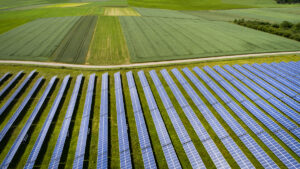The precious metals market is back in vogue with prices for both gold and silver running at full speed.
But while attention is pinned mostly on gold hitting record highs, ANZ analysts believe silver will outperform gold and regain its lustre after remaining flat for most of 2023.
So far this year, the silver price has gained more than 20%, hitting US$27.9/oz since early March with fresh expectations it may rise above $31 per ounce in the second half of the year.
ANZ’s senior commodity strategist Damien Hynes says investment demand for gold and silver will pick up amid heightened geopolitical tensions and prospects of an easing monetary cycle.
“This can lead to silver outperforming gold in 2024,” he says.
“Normally, silver outperforms gold in a rising gold price environment, but this didn’t happen last year due to lacklustre investment flows for both metals.
“Slower mine production growth and strong industrial demand also suggests supply is lagging demand, which will keep the market in a structural deficit.”
With key market drivers like easing rate cuts yet to materialise, Hynes lifts his gold and silver price forecasts through 2024 and 2025 with the anticipation that gold will trade around US$2,500/oz and silver to move above US$31/oz by the end of 2024.
For ASX-listed silver companies, the lift in prices means that any mine development with the precious metal in economic quantities will ultimately return more bang for their buck.
Whether silver is the mainstay or a valuable by-product, potential returns will be higher, which in turn translates into a project that’s more likely to receive the final green light.
Historic shift in silver demand
And it’s not just prices that have been growing at a steady pace.
Silver is a metal of two heads with half of its demand from investment-like categories such as silverware, jewellery, and bar and coin investment, while the other half serves industrial needs.
For the first time ever, silver’s industrial demand now represents more than half of the total demand for the metal with its use in solar photovoltaics growing 16% per year over the last 9 to 10 years.
Sprott’s senior portfolio manager Maria Smirnova says nearly 190Moz of silver was used for solar panel production in 2023, up from 140Moz in 2022.
“We think that silver’s use in solar alone could easily reach 300 million ounces – that’s 30% of silver supply, including mine and scrap supply,” she says.
That translates to an incremental 100Moz of silver just for solar production, which means another five to 10 big mines.
Silver’s electrical and thermal conductivity – the highest among all the metals – also makes it an ideal component of electric vehicles with nearly every electrical connection in an EV requiring silver.
Depending on the model, EVs contains up to 50g of the stuff, and as the world continues to switch from ICEs to EVs and hybrids, this number per vehicle will continue to rise.
While green-related applications played a huge part in lifting silver’s industrial demand to a record high of 654.4Moz, its use in emerging growth areas like the nuclear industry are also beginning to take shape.
According to the Silver Institute’s ‘World Silver Survey 2024’, the nuclear industry uses the metal for control rods, which are embedded within reactors and contain around 80% silver.
Another potential source of offtake is its use in AI, with wearable devices such as electronic skin patches likely to become a vital healthcare tool.
“Silver nanoparticles are used in such patches for both their excellent deformability and high conductivity,” the World Silver Survey says.
“Another potential end-use is from developments in biotechnology, where the use of silver nanowires in neuromorphic engineering may come to surpass current hardware technology.”
A decade of standstill as future supply remains grim
Yet strong demand and higher prices don’t always correlate to an increase in supply.
In silver’s case, Smirnova says mine supply has been stagnant for the last 10 years with mine production in 2013 hitting 845Moz.
“If we look back at last year, projections are for about 820 million ounces – that’s a decline of 25 million ounces,” she says.
“Even in 2022, it was 837 million ounces. The takeaway is mine supply has not changed in 10 years.”
The supply outlook isn’t looking much better, with a marginal decline forecast for 2024, pushing the mark deficit up by 17% to 215.3Moz for the year.
Maronan Metals (ASX:MMA) managing director Richard Carlton says a key part in seeing significant additional production will depend on new base metal deposits being discovered and developed.
“Only 17% of silver production comes from silver, or purely precious metal mines,” he tells Stockhead.
“Silver is a co-product of either copper, lead or zinc so many of the world’s biggest silver mines are base metal mines with strong silver credits.
“In Australia, silver supply mainly comes from the Carpentaria Zinc Province with the giant Broken Hill, Cannington, Mount Isa and McArthur River deposits being some of the world’s best.”
South 32’s (ASX:S32) Cannington mine, 200km southeast of Mount Isa, was first discovered as an anomaly 30 years ago and is now Australia’s largest silver producer.
MMA’s silver-rich deposit of the same name, only 90km from Cannington, is one of Australia’s largest, undeveloped silver projects with an inferred and indicated 30Mt silver-lead resource that is open at depth.
Carlton reckons Maronan could transition from explorer to miner with limited financial and technical risk given the project’s shallow, high value mineralisation.
“A good example of a shallow high-grade project turning an explorer into a miner would be the discovery and development of the DeGrussa copper deposit by Sandfire back in 2009,” he says.
“Although not copper, the inground value of the silver with lead at Maronan compares favourably with that of DeGrussa at the time of discovery and gives us confidence that we could develop this project on our own without a JV partner.”
The Maronan deposit was previously held under the watch of Red Metal (ASX:RDM), until the company spun the deposit out into Maronan Metals so it could focuse on its Sybella rare earths project near Mt Isa in Queensland. Red Metal retains nearly 53% in Maronan at the time of writing.
Other emerging silver players on the ASX
Supply will undoubtedly grow as the investment case for silver continues to build, putting a handful of ASX explorers in the box seat.
Iltanti (ASX:ILT) is exploring for the precious metal at its Orient project, 100km inland from Cairns in the historical mining area of Herberton.
An 11-hole drilling campaign for 2,300m aims to infill some adjacent areas to previous holes, particularly in the northeast where no drilling has been done before.
The program will cover a 1800m strike extent and, dependent on results, will form the basis of eventual infill drilling to a 100m x 50m grid which will go towards an inferred resource estimate.
ILT managing director Donald Garner says the company hopes to deliver an initial resource by the end of the season.
Over in South Australia, Investigator Resources (ASX:IVR) is progressing its Paris project through the definitive feasibility study (DFS) phase, due for completion later this year.
The project boasts a 24Mt resource at 73g/t silver and 0.41% lead for 57Moz of silver and 99,000t of lead with an additional 76 holes – drilled since the 2021 resource update – included in that resource estimate.
IVR has appointed consultancy group JBS&G to undertake environmental field work including a comprehensive flora and fauna survey while Mincore has been appointed to complete design and cost estimation for the project’s processing plant and infrastructure.
Argent Minerals (ASX:ARD) is another stock on the ASX with decent exposure via its advanced Kempfield gold-silver base metal project in NSW.
Its share price is up ~90% since the start of the month with various sampling programs set to bolster the already substantial 127.5Moz equivalent silver bounty.
Highlights from the newest rock chip sampling program include gold assays up to 23g/t gold (Au), 25g/t, silver (Ag), 0.26% copper (Cu), 0.88% lead (Pb) and 0.12% zinc (Zn).
According to ARD managing director Pedro Kastellorizos the results confirm that the mineralised footprint at Kempfield continues to expand with these zones hosting the same geology and geochemical signatures as the main mineralisation over the Kempfield deposit.
Silver stock to watch
But pure play silver companies are a rarity on the ASX, making one of the newest listees a unique opportunity.
Sun Silver, set to list under the code ‘SS1’, owns the Maverick Springs project in Elko County, Nevada boasting an inferred resource of 125.4Mt grading 72.4g/t silver equivalent for a contained 292Moz silver equivalent.
The company plans to begin mine and processing studies for Maverick Springs along with early-stage studies to assess the potential feasibility of silver paste and solar energy opportunities.
Along the way, the company will progress US Department of Energy, Department of Defence and Inflation Reduction Act grant applications.
Sun Silver also expects the growth potential at Maverick Springs to draw attention.
While the existing resource is certainly sizeable enough, the current mineralisation model covers less than a quarter of the project’s area.
At Stockhead we tell it like it is. While Maronan Metals, Argent Minerals and Iltani Resources are Stockhead advertisers, they did not sponsor this article.
The post Riding the tech express: Tomorrow’s industries that are driving industrial demand for silver appeared first on Stockhead.






















